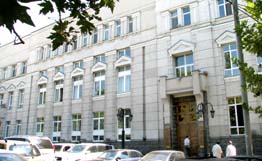


ArmInfo. The Central Bank of Armenia has once again downgraded the economic growth forecast for 2016 to 1.3-1.8% versus previously forecasted 2.8-3.4%, according to the CBA's Monetary Policy Program for Q4 2016. The CBA explains this with slackening rates of growth in industry and services.
By late 2017, the economic growth may total 2.8-4.3% (versus previously forecasted 3- 4.5%) due to the effective implementation of the governmental program on investment and export promotion, gradual improvement of the foreign economic situation and influence of the ongoing structural reforms. The long-term balanced economic growth is estimated at 4-5%, while current estimation is 1-1.5%.
In the industrial sector, the growth forecast for 2016 has been downgraded to 5.5-6.1% versus previous 7.9-8.7%; in construction the forecast has been once again downgraded to negative 1.8-2.6% (versus the previous forecast from negative 1.3% to negative 0.5%); in services the growth forecast has been downgraded to 2.2- 2.6% versus previous 3.8-4.4%; in agriculture the growth forecast has been downgraded to 0.7-0.1% versus previously forecasted 1-1.8% growth. In the foreseeable future the growth of industry will stabilize within 5-6%, the services will grow by 3-4%, construction will grow by 0.5-1%, agriculture will improve dynamics from negative to positive 4-5%.
According to the CBA's forecast, in 2016 the amount of individuals' transfers will be 6-8% (in terms of USD). This demonstrates a decline slowdown from 9-12% as compared with the forecast made in early 2016. However during 2017 positive dynamics of transfers within 4-6% will be registered related to forecasted recovery of economic growth in Russia.
Forecast of the deficit of the current account against GDP remains the same: 2-3% with slight reduction in 2017 to 1.5-2.5%, stabilizing within 1-2% in the mid-term outlook. The CBA says that export of commodities and services will grow by 14% (versus previously forecasted 11-13%), while import will stagnate at 0% (versus previous forecast of 1.5-3.5% decline), while in 2017 in conditions of weak world demand maintenance of low level of prices on metals and slackening of growth rates in industrial sector, growth of export will slacken to 4-6%, while growth of import will slacken to 0-2% due to continuing weak domestic demand.
To recall, the International Monetary Fund (IMF) has upgraded its forecast for Armenia's economic growth in 2016 to 3.2% from 2.25-2.5%, with acceleration to 3.4% in 2017. Besides, IMF in its report forecasts that prices in Armenia will decline by 0.5%. The World Bank in its November report has upgraded its forecast of Armenia's economic growth to 3.1% (vs previous 1.9%), and 3.3%-3.6% in 2017-2018. EBRD forecasts 2% economic growth in 2016.
The state budget of Armenia fixed 2.2% GDP growth in 2016, deflator index - 4%, 12- month inflation - 4% (+1.5%). According to the National Statistical Service of Armenia in Jan-Oct 2016, the economic activity growth in Armenia slackened to 0.4% from 3.5% in Jan-Oct 2015. Services and industry remained the driving force of economic activity: services grew by 7.7%, and industry - by 6.5% versus Jan-Oct 2015. Export in Jan-Oct 2016 grew by 19.8% y-o-y, while import dropped by 0.3% versus 2.2% and 26.6% decline respectively in previous year. According to the Central Bank, in 2015 the amount of individuals' transfers to Armenia dropped by 24% to $1.6 bln, while the transfers from Armenia declined by 16% to $0.8 bln. Russia had the biggest share in both the inflow and outflow - 63% and 37%, respectively. The net inflow of transfers to Armenia from Russia started dropping in 2014 (down 13%) following growth in the previous four years: in 2010 - by 24%, in 2011 - by 25%, in 2012 - by 18.2%, in 2013 - by 7.2%. Over the past 2 years, the inflow of transfers from Russia to Armenia dropped by almost $730 mln, in 2015 alone - by $554 mln versus 512mln USD decline in the crisis-affected year 2009.